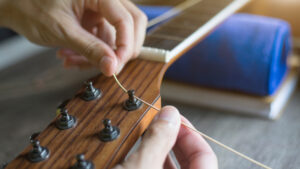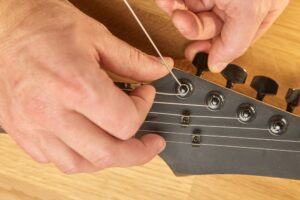 If you’ve just signed up for guitar lessons in Atlanta, congratulations! You’re in for an exciting journey to learning a classic instrument that will bring you great joy and fulfillment for years to come. In addition to learning the ins and outs of how to play the guitar, one important aspect of learning to take care of your guitar is learning how to change the strings.
If you’ve just signed up for guitar lessons in Atlanta, congratulations! You’re in for an exciting journey to learning a classic instrument that will bring you great joy and fulfillment for years to come. In addition to learning the ins and outs of how to play the guitar, one important aspect of learning to take care of your guitar is learning how to change the strings.
Now, restringing a guitar probably sounds really daunting, especially if you’ve never done it before. But, as you’ll learn in your guitar lessons in Atlanta, it’s a great skill to have as a guitar player. It’ll save you time and money, and you’ll be able to keep your guitar in top shape, so you’ll always sound great when you play.
When it comes to which strings to buy, that’s a completely personal preference. Typically lighter ones are better for beginners. Coated strings can also be great for beginners, but just know you’ll pay a slightly higher price. If you are playing your guitar for at least 30 minutes every day, you’ll likely want to change your strings every 3-4 months. Your guitar strings and board will collect dust, dead skin cells, etc., after time, and you’ll start to be able to hear in your strings that it’s time for a change.
To help you become comfortable changing your own strings, we’ve put together a step-by-step process.
Get Everything in One Place
Great chefs use a phrase and philosophy, “mise en place,” as they are getting their kitchens ready to produce delicious food. This French phrase means to “have everything in place” before you start cooking. The same is true when you need to restring your guitar. You should have everything you need in place before you begin.
So what do you need? Just a few things:
- Wire cutters
- String winder
- Tuner
- A new set of strings
- Optional: cloths, spray, or lemon oil for cleaning
Remove the Old Strings
- Release tension by slackening each string by several turns (start with 5) until they cannot make a note.
- Using your wire cutters, cut the strings around the 12th fret.
- Unwind the strings from the tuning pegs.
- Using your winder tool, remove the string pins.
- Repeat these steps for every string.
- Rewind all the used strings and put them in the trash.
Clean Your Guitar
This step is completely optional, but while you’ve got your guitar in its current state (stringless and unplayable), which it’s only in every few months, you should probably give your guitar a quick cleaning. We typically recommend lemon oil for the fretboard. During your lessons, you can ask your Atlanta guitar teacher for their recommendations for cleaning tools and polishes for the body.
Put a few drops of lemon oil on a cloth, and use the cloth to spread the lemon oil over the fingerboard. Let it soak into the wood for around 30 seconds before wiping it down again.
Putting the Strings on the Bridge
Look at your new pack of strings to see the recommended order with which you should put the strings back on. This is essential for restringing your guitar correctly. Most packages recommend you start with the bass strings.
- Create a kink in each string about 2-3cm from the ball of the string.
- Carefully put the ball-end of the string into the hole. You should put about 10cm worth of string into the hole.
- Push the ball-end of the string down using the bridge pin. The string should sit in the groove of the pin, and the groove should point straight down.
- Slowly and carefully tug on the string while holding the peg down until the string is tight.
- Repeat these steps with each string.
Winding the Strings
- Line up each hole of each machine head to make sure the holes are pointing straight down the neck.
- Draw the string over the saddle, over the nut, and thread the string through the appropriate hole.
- Pull the string tight so you have some slack. The amount of slack you’ll need will vary with the string type and thickness. The 6th string may need less (5cm or so), while your 1st string might need around 10cm.
- With the excess string, wind counterclockwise around the post, trying to keep some of the tension in the string as you wind. The string running down the neck of your guitar (the part you’ll play) should always stay on the inside of the post.
- When you’re done winding, make sure the new wraps are on the bottom.
- Tighten the string a few times until there’s a little bit of tension in the string.
- Repeat these steps, staying in the order of strings from thickest first to thinnest strings last.
Finishing Up
- When you’ve completely wound all the strings, then you can start bringing them up to the correct pitch. Use your tuner for this.
- Alternate between strings, and don’t bring one string up to pitch at a time, but move back and forth between strings to maintain the tension in the neck of the guitar.
- Once your guitar is in tune, you’ll need to stretch the strings. This is important as it will keep your guitar from losing its tuning. Over the body of your guitar, simply pull slightly towards you on each string. You may have to tune your guitar back up after doing this.
Guitar lessons in Atlanta are a great place to learn how to play and care for your guitar. From tuning to cleaning to restringing your guitar, a Lessons In Your Home instructor can help you master the necessary steps to keep your guitar well-maintained. Guitar maintenance is crucial to ensuring your guitar has a long, healthy life and stays in good shape for you to enjoy for a long time. You’ll appreciate the time and money you’ll save by learning to take care of your guitar yourself. We’re certain that after a few months, you’ll also be an expert in restringing your guitar.
If you are interested in learning more about the guitar or if you want to sign up for lessons, contact us! Our teachers come right to your home for every lesson, plus we offer virtual music lessons, too. Our online music lessons are taught by local music teachers with live lessons tailored to your family!
